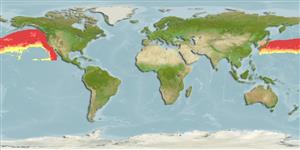Actinopterygii (ray-finned fishes) >
Myctophiformes (Lanternfishes) >
Myctophidae (Lanternfishes) > Myctophinae
Etymology: Symbolophorus: Greek, symbolon, ou = mark, signal + Greek, pherein = to carry (Ref. 45335); californiensis: Named after California in the USA (Ref. 6885).
Environment / Climate / Range
Ecology
Marine; pelagic-oceanic; depth range 557 - 1497 m (Ref. 27311). Subtropical, preferred ?; 55°N - 18°N, 131°E - 112°W
North Pacific: Japan, and from Alaska to Baja California, Mexico.
Size / Weight / Age
Maturity: Lm ? range ? - ? cm
Max length : 11.0 cm SL male/unsexed; (Ref. 559)
Short description
Morphology | Morphometrics
Dorsal
spines
(total): 0;
Dorsal
soft rays
(total): 13-15;
Anal
spines: 0;
Anal
soft rays: 19 - 21;
Vertebrae: 37 - 40. Adipose fin short based and slender; pectorals long, reaching beyond pelvic insertion but not reaching anus (Ref. 6885). Black dorsally, silvery on sides; dusky on bases of fins; light from photophores pale green (Ref. 6885). Branchiostegal rays: 9-10 (Ref. 31442).
Epipelagic to mesopelagic, at surface at night (Ref. 31442). Adults feed on small crustaceans (Ref. 11712). Oviparous, with planktonic eggs and larvae (Ref. 31442). Lipid content is 4.3 % in fresh body weight, while wax ester is present in trace amounts (Ref. 9197). Preyed upon by fishes, cephalopods, birds and marine mammals. Easily attracted to a light suspended above the water at night and many are captured in dipnets (Ref. 4525).
Life cycle and mating behavior
Maturity | Reproduction | Spawning | Eggs | Fecundity | Larvae
Masuda, H., K. Amaoka, C. Araga, T. Uyeno and T. Yoshino, 1984. The fishes of the Japanese Archipelago. Vol. 1. Tokai University Press, Tokyo, Japan. 437 p. (text). (Ref. 559)
IUCN Red List Status (Ref. 115185)
CITES (Ref. 94142)
Not Evaluated
Threat to humans
Harmless
Human uses
Tools
Special reports
Download XML
Internet sources
Estimates of some properties based on models
Phylogenetic diversity index (Ref.
82805): PD
50 = 0.5039 [Uniqueness, from 0.5 = low to 2.0 = high].
Trophic Level (Ref.
69278): 3.1 ±0.27 se; Based on food items.
Resilience (Ref.
69278): High, minimum population doubling time less than 15 months (K=0.4).
Vulnerability (Ref.
59153): Low to moderate vulnerability (28 of 100) .
